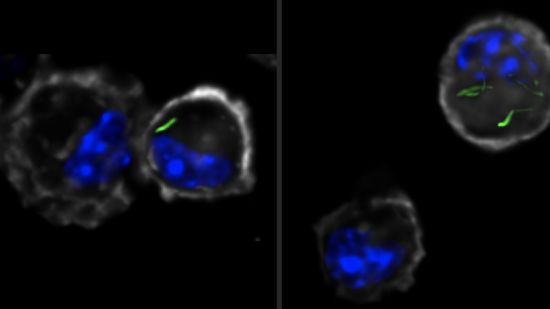January 18, 2024
REMODELING THE IMMUNE SYSTEM TO FIGHT TUBERCULOSIS
Collaborative team from UMass Amherst and Seattle Children’s Research Institute uncovers how prior exposure to bacteria changes the lung’s innate immune response – and what it might mean for vaccines

Mycobacterium tuberculosis-infected alveolar macrophages at day 10 after infection. Mtb in green.
Infection of the alveolar macrophages is tuberculosis’s first step— but what if we could change that?
Credit: Alissa Rothchild
Tuberculosis, caused by the bacterium Mycobacterium tuberculosis (Mtb) kills upwards of 1.6 million people a year, making it one of the leading causes of death by an infectious agent worldwide—and that number is only growing larger. How, exactly, Mtb evades the immune system isn’t yet known, but a collaborative team of researchers from the University of Massachusetts Amherst and Seattle Children’s Research Institute recently discovered something surprising: prior exposure to a genus of bacteria called Mycobacterium seems to remodel the first-line defenders in the body’s immune system. Furthermore, how those cells are remodeled depends on exactly how the body is exposed. These results, published recently in PLOS Pathogens, suggest that a more integrated treatment approach that targets all aspects of the immune response could be a more effective strategy in the fight against tuberculosis.
“We breathe in thousands of liters of air every day,” says Alissa Rothchild, assistant professor in the Veterinary and Animal Sciences Department at UMass Amherst and the paper’s senior author. “This essential process makes us incredibly vulnerable to inhalation of all sorts of potentially infectious pathogens that our immune systems have to respond to.”
Systems, plural. When we think of immunity, we typically think of the adaptive immune system, which is when prior exposure to a pathogen—say, a weakened version of chickenpox—teaches the immune system what to guard against. Vaccination is the most common tool that we use to teach our adaptive immune systems what to look out for.
While the adaptive immune system is the major focus of most vaccine research (think protective antibodies induced by COVID-19 vaccines), it is not the body’s first responder—that would be the innate immune system and its ranks of macrophages. The macrophages are the first-line defenders in the tissues that recognize and destroy pathogens and also call for backup. One way they do this by turning on different inflammatory programs that can change the tissue environment.
In the case of the lungs, these macrophages are called alveolar macrophages (AMs). They live in the lung’s alveoli, the tiny air sacs where oxygen passes into the bloodstream—but, as Rothchild has shown in a previous paper, AMs don’t mount a robust immune response when they’re initially infected by Mtb. This lack of response seems to be a chink in the body’s armor that Mtb exploits to such devastating effect. “Mtb takes advantage of the immune response,” says Rothchild, “and when they infect an AM, they can replicate inside of it for a week or longer. They effectively turn the AM into a Trojan Horse in which the bacteria can hide from the body’s defenses.”
“But what if we could change this first step in the chain of infection?” Rothchild continues. “What if the AMs responded more effectively to Mtb? How could we change the body’s innate immune response? Studies over the last 10 years or so have demonstrated that the innate immune system is capable of undergoing long-term changes, but we are only beginning to understand the underlying mechanisms behind them.”
To test conditions where the innate immune response might be remodeled, Dat Mai, a research associate at Seattle Children’s Research Institute and the first author of the paper, Rothchild and their colleagues designed an experiment using two different mouse models. The first model used the BCG vaccination, one of the world’s most widely distributed vaccines and the only vaccine used for tuberculosis. In the second model, the researchers induced a contained Mtb infection, which they previously showed protects against subsequent infections in a form of concomitant immunity.

“Studies over the last 10 years or so have demonstrated that the innate immune system is capable of undergoing long-term changes, but we are only beginning to understand the underlying mechanisms behind them.”
Alissa Rothchild, assistant professor in veterinary and animal sciences at UMass Amherst
Weeks after exposure, the researchers challenged the mice with aerosolized Mtb and infected macrophages were taken from each mouse model for RNA sequencing. There were striking differences in the RNA from each set of models.
While both sets of AMs showed a stronger pro-inflammatory response to Mtb than AMs from unexposed mice, the BCG-vaccinated AMs strongly turned on one type of inflammatory program, driven by interferons, while the AMs from the contained Mtb infection turned on a qualitatively different inflammatory program. Other experiments showed that the different exposure scenarios changed the AMs themselves, and that some of these changes seem to be dependent on the greater lung environment.
“What this tells us,” says Rothchild, “is that there’s a great deal of plasticity in the macrophage response, and that there’s potential to therapeutically harness this plasticity so that we can remodel the innate immune system to fight tuberculosis.”
This research, which was supported by the National Institutes of Health and the National Institute of Allergy and Infectious Disease, is part of a much bigger, global, cross-species effort to comprehensively understand the immune responses to eliminate tuberculosis, called IMPAc-TB, for Immune Mechanisms of Protection Against Mycobacterium Tuberculosis.
Dr. Kevin Urdahl, professor of pediatrics at Seattle Children’s Research Institute, lead PI for this IMPAc-TB consortium, and one of the paper’s co-authors, says that “the overall goal of the program is to elucidate how the immune system effectively controls or eradicates the bacteria that causes tuberculosis so that effective vaccines can be developed.This is an important part of the larger IMPAc-TB program because we will be assessing the responses of human alveolar macrophages recovered from individuals who have recently been exposed to Mycobacterium tuberculosis in a TB endemic region. The findings of Rothchild’s team will help us interpret and understand the results we obtain from the human cells.”
Contact
Patty Shillington
Associate News Editor
News & Media Relations Office
UMass Amherst
pshillington@umass.edu
Cell: 305-606-9909
www.umass.edu/newsoffice
Source: https://www.umass.edu/news/article/remodeling-immune-system-fight-tuberculosis
"Reproduced with permission - University of Massachusetts Amherst"
University of Massachusetts Amherst
For more HIV and AIDS News visit...
Positively Positive - Living with HIV/AIDS:
HIV/AIDS News |